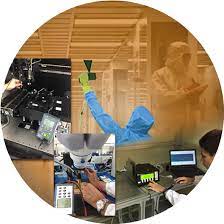
Keeping an electrostatically balanced, clean, and safe atmosphere is crucial in today’s tech-driven, fast-paced world for many different types of businesses. Room ionisers, autoclaves, ESD testing, ESD audits, static control, and AMC analysers are tools that play an important role in many different types of facilities, including medical facilities, semiconductor labs, pharmaceutical plants, and other facilities that sterilise devices. A Room Ionizer—What Is It? Eliminating Static in Highly Sensitive Areas A room ioniser is a must tool for removing airborne static electricity. These ions are absolutely vital for removing static charge by holding onto free electrons since electrostatic discharge (ESD) may cause failure of components, fire hazards, or contamination. Uses for Room Ionisers Safeguarding delicate parts from dust. Preventing Electrostatic Discharge Damage to Chips. Reduced particle contamination in pharmaceuticals. The Autoclave: The Super Standard for Sanitation Sterilising tools, materials, and equipment is the job of an autoclave, a pressurised device that employs steam. The medical field, laboratories dealing with microbes, and food processing all rely on it heavily. Esd Testing: What Is It? Examining the sensitivity of materials, people, and places to electrostatic discharge is what ESD testing is all about. This aids in safeguarding sensitive electronic equipment and ensuring compliance with ANSI/ESD S20.20 regulations. Classifications of ESD Evaluations Testing of Footwear and Wrist Straps Evaluation of Floor and Worksurface Resistance Accurate Ionisation Testing Testing for Charge Generation and Its Importance Stops devices from experiencing unanticipated breakdowns Cuts down on warranty returns Raises the bar for the whole product A Thorough Evaluation of ESD Controls: An Audit of Static Controls What Is an ESD Audit? The electrostatic control measures of a facility are examined and evaluated in detail during an ESD Audit. It verifies that all procedures, employees, and tools are up to par. Central Domains Assessed Grounding mechanisms Electrostatic Protected Area (EPA) compliance and ioniser performance Protocols for the safe handling of materials Regularity and Documentation Ideal audit intervals are quarterly or biannually. Include pictures, test findings, and what was done to fix the problem in your report. Why Static Control Is Necessary for ESD Management and What It Is Crucial Everything that is done or anything that is used to keep static electricity from being created, accumulated, or discharged is part of static control. It is the bedrock of ESD security in every setting. Tools for Static Control Wrist straps and antistatic matting Electric floor covering clothes that are immune to electrostatic discharge Hybrid Room Mists Putting a Static Control Scheme into Place Evaluate Potential Dangers Educate Employees Conduct Regular Reviews and Audits Record-Keeping and Ongoing Development An AMC analyser, what is it? In clean room settings, dangerous molecular impurities can be detected using an AMC Analyser. The product’s integrity could be compromised by acids, bases, volatile organic compounds (VOCs), and condensable. Principal Markets for AMC Analysers Production of Pharmaceuticals and Semiconductors Production of Optics and Aerospace Vehicles Conclusion Efficiency in operations is directly correlated to one’s familiarity with and skill with environmental control technologies such as room ionisers, autoclaves, ESD testing, audits, static controls, and AMC analysers. We rely on these tools to minimise product recalls, ensure compliance, secure sensitive components, and maintain sterile conditions. Integrating these technologies into your operational strategy is not only a best practice, but a strategic imperative, regardless of whether you are redesigning existing facility or beginning from fresh.